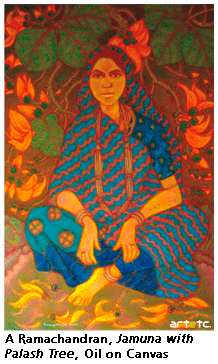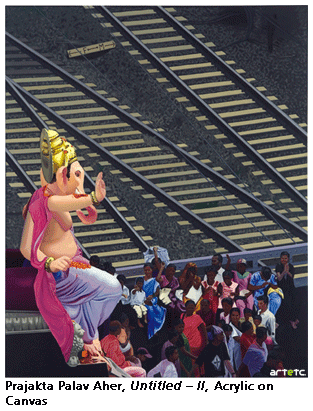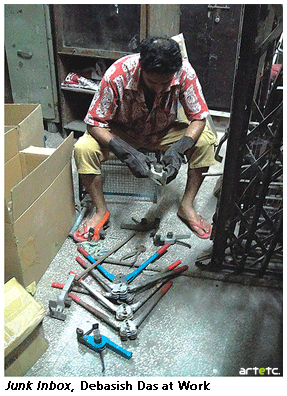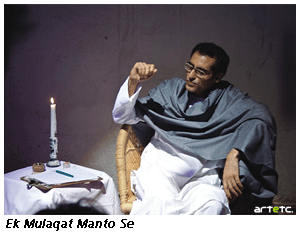- Publisher's Note
- Editorial
- Looking from the Other Side
- Women in Rabindranath Tagore's Paintings
- Ramkinkar Baij's Santhal Family
- The Birth of Freedom in Moments of Confinement
- Jamini Roy's Art in Retrospect
- The Great Journey of Shapes: Collages of Nandalal Bose
- Haripura Posters by Nandalal Bose: The Context and the Content
- The Post-1960s Scenario in the Art of Bengal
- Art Practice in and Around Kolkata
- Social Concern and Protest
- The Dangers of Deifications
- Gobardhan Ash: The Committed Artist of 1940-s
- Gopal Ghose
- Painting of Dharmanarayan Dasgupta: Social Critique through Fantasy and Satire
- Asit Mondal: Eloquence of Lines
- The Experiential and Aesthetic Works of Samindranath Majumdar
- Luke Jerram: Investigating the Acoustics of Architecture
- Miho Museum: A Structure Embedded in the Landscape
- Antique Victorian Silver
- Up to 78 Million American Dollars1 !
- Random Strokes
- Are We Looking At the Rise of Bengal
- Art Basel and the Questions it Threw Up
- What Happened and What's Forthcoming
- Art Events Kolkata, May – June 2012
- Mumbai Art Sighting
- Delhi Dias
- Art Bengaluru
- Preview June, 2012 – July, 2012
- In the News, June 2012
ART news & views
Delhi Dias
Issue No: 30 Month: 7 Year: 2012
by Lopamudra Pakira
Feminine tales
 The amazing art destination for art enthusiasts proudly presents masterpieces by the most talented and renowned Indian artists - MF Husain, the School of Raja Ravi Varma, A Ramachandran, Arup Das, Anjolie Ela Menon, FN Souza, Jamini Roy, Ravinder Reddy, Arpita Singh, Anju Dodiya, Nalini Malani, Akbar Padamsee, Sunil Gupta and Jogen Chowdhury. The exhibition is curated by Julia Villaseñor Bell. Inscribing the Female Body presents a wide range of works by artists in the Vadehra Art Gallery collection that examines the female figure in its varied representations.
The amazing art destination for art enthusiasts proudly presents masterpieces by the most talented and renowned Indian artists - MF Husain, the School of Raja Ravi Varma, A Ramachandran, Arup Das, Anjolie Ela Menon, FN Souza, Jamini Roy, Ravinder Reddy, Arpita Singh, Anju Dodiya, Nalini Malani, Akbar Padamsee, Sunil Gupta and Jogen Chowdhury. The exhibition is curated by Julia Villaseñor Bell. Inscribing the Female Body presents a wide range of works by artists in the Vadehra Art Gallery collection that examines the female figure in its varied representations.
The female figure is a ubiquitous element in art - a modernist trope, a figure vested with symbolic meaning, an icon and equally a means of self-representation by women artists. Artists have worked with this linguistic form of the female body to explore diverse layers of meaning of women's position as well as resolve certain formal issues. The difficult place that women occupy in society and in art has been matter of inspiration and critique amongst male and female Indian artists across generations. Inscribing the Female Body presents a wide range of works by artists in the Vadehra Art Gallery collection that examine the female figure in its varied representations. This exhibition, Inscribing the Female Body is a selection from the Vadehra Art Gallery collection and was on till the 22nd of May.
Of Voyages
 Another ongoing exhibition at Vadehra Art Gallery would be Of Places and Journeys. The featuring Artists Annu Matthew, Arpita Singh, Ashim Purkayastha, Atul Bhalla, Gauri Gill, Gulammohammed Sheikh, Om Soorya, Prajakta Palav Aher, Praneet Soi, Rameshwar Broota, Shilpa Gupta, Sunil Gupta & Tushar Joag. Travelling as a source of inspiration is not only the moment when new places are registered in the mind by spatial displacement, to be then transformed inside our memories, but also when common places are renewed when seen from the viewpoint of others or by ourselves with different eyes cast upon. Habitual landscapes are presented in novel ways, unknown places turn familiar, the artist's proximity and their original gaze is our door to new worlds. This selection of works from the Vadehra Art Gallery collection is a one-way ticket to exotic places and the corner of our neighbourhood streets. Photography, painting, drawing and video are the media explored by artists excelling in these domains. From internal and spiritual journeys, to the search of one's identity at the encounter of the 'other', this exhibition showcases important works by contemporary artists that have made travel, landscape and the pursuit of individual identity the pinpoint of their artistic research. This exhibition too was on till the 22nd of May.
Another ongoing exhibition at Vadehra Art Gallery would be Of Places and Journeys. The featuring Artists Annu Matthew, Arpita Singh, Ashim Purkayastha, Atul Bhalla, Gauri Gill, Gulammohammed Sheikh, Om Soorya, Prajakta Palav Aher, Praneet Soi, Rameshwar Broota, Shilpa Gupta, Sunil Gupta & Tushar Joag. Travelling as a source of inspiration is not only the moment when new places are registered in the mind by spatial displacement, to be then transformed inside our memories, but also when common places are renewed when seen from the viewpoint of others or by ourselves with different eyes cast upon. Habitual landscapes are presented in novel ways, unknown places turn familiar, the artist's proximity and their original gaze is our door to new worlds. This selection of works from the Vadehra Art Gallery collection is a one-way ticket to exotic places and the corner of our neighbourhood streets. Photography, painting, drawing and video are the media explored by artists excelling in these domains. From internal and spiritual journeys, to the search of one's identity at the encounter of the 'other', this exhibition showcases important works by contemporary artists that have made travel, landscape and the pursuit of individual identity the pinpoint of their artistic research. This exhibition too was on till the 22nd of May.
Beauty in the Junk
 Artists are expected to use their creative ability to turn out industrial scrap metal, wood, plastic, garment accessories, found & allied objects etc, into interesting work of art, that can define & set a new vocabulary in the art terms In the fast developing country like India, where consumerism is on the high, with a lot of industrial units on the rise. There is a lot of material use, for common utility, and other commercial purposes. With the use there is a lot of wastage too and also lot of byproducts etc. Looking at the waste, one can hope for a re-use or disposal. But at this juncture, a little bit of creativity comes to the rescue, not always though, excluding the hazardous waste. Down the history 'art', has been always a way out to turn things into sometimes beautiful, useful objects, not always for utility purpose, but for beautification, or for aesthetic pleasure too. With these notion in mind, NIV Art Centre, New Delhi, took an initiative in these direction to invite artists to work on projects that saw some junk materials turned out into beautiful art objects/ works. The project, Junk Inbox - Art With Beauty & Social Concern, was curated by Rajan Fulari, incharge printmaking studio, Lalit Kala Academy, Garhi Artists Village, New Delhi. The event started on 1st June and ended on 15th June. All artists worked on singular & also on a collaborative work which tested their prowess to turn out the available materials into works of art & beauty. The participating artists were Tridib Dutta, Rajesh Kumar Rajan & Debasish Das.
Artists are expected to use their creative ability to turn out industrial scrap metal, wood, plastic, garment accessories, found & allied objects etc, into interesting work of art, that can define & set a new vocabulary in the art terms In the fast developing country like India, where consumerism is on the high, with a lot of industrial units on the rise. There is a lot of material use, for common utility, and other commercial purposes. With the use there is a lot of wastage too and also lot of byproducts etc. Looking at the waste, one can hope for a re-use or disposal. But at this juncture, a little bit of creativity comes to the rescue, not always though, excluding the hazardous waste. Down the history 'art', has been always a way out to turn things into sometimes beautiful, useful objects, not always for utility purpose, but for beautification, or for aesthetic pleasure too. With these notion in mind, NIV Art Centre, New Delhi, took an initiative in these direction to invite artists to work on projects that saw some junk materials turned out into beautiful art objects/ works. The project, Junk Inbox - Art With Beauty & Social Concern, was curated by Rajan Fulari, incharge printmaking studio, Lalit Kala Academy, Garhi Artists Village, New Delhi. The event started on 1st June and ended on 15th June. All artists worked on singular & also on a collaborative work which tested their prowess to turn out the available materials into works of art & beauty. The participating artists were Tridib Dutta, Rajesh Kumar Rajan & Debasish Das.
Mulakat with Manto
 From its modest beginnings in 1997, Khoj has nurtured vibrant imaginations and created unconventional synapses between disciplines. To carry forth its uncompromising commitment towards creative thinking, Khoj is building an institutional infrastructure in India for making, exhibiting and researching contemporary art. It is renovating its premises to create multi-purpose project spaces, artists' studios and residences, an open access archive and library, a terrace and cafe. During this period, Khoj will not be holding any major residencies but a series of events will respond to the site at various stages of the building's breaking and making. Interrogating the dynamism of Khoj as a construction site, the events will engage with the building to create conversations about its past, present and future.
From its modest beginnings in 1997, Khoj has nurtured vibrant imaginations and created unconventional synapses between disciplines. To carry forth its uncompromising commitment towards creative thinking, Khoj is building an institutional infrastructure in India for making, exhibiting and researching contemporary art. It is renovating its premises to create multi-purpose project spaces, artists' studios and residences, an open access archive and library, a terrace and cafe. During this period, Khoj will not be holding any major residencies but a series of events will respond to the site at various stages of the building's breaking and making. Interrogating the dynamism of Khoj as a construction site, the events will engage with the building to create conversations about its past, present and future.
Khoj International Artists Association presented Ek Mulaqat Manto Se, a solo performance reflecting the life and times of Saadat Hasan Manto by Ashwath Bhatt on May 11, 2012 at Khoj Studios, New Delhi.
Marking the 100th birth anniversary of Saadat Hasan Manto, Ek Mulaqat Manto Se reflects the life and times of Saadat Hasan Manto. A biographical play, this solo performance uses Manto's articles and stories unearthing Manto's writing and reveal its relationship to the trauma of Partition. Some of the texts used in the performance are Manto, Main Afsana Kyun Kar Likhta Hoon, Khol Do, Kal Sawere Jo Meri Ankh Khuli and Deewaroon Pe Likhna.
Ashwath Bhatt, who graduated from the National School of Drama, New Delhi & LAMDA, London with a specialisation in acting, regularly performs and teaches at premier institutions in India and abroad. He is widely known for his work on Red Nose Clowning; he established the Theatre Garage Project in 2007. The slogan of his work is 'finding something in nothing'. The play was performed in Urdu.